India's Environmental Future
First published in Sanctuary Asia,
Vol. 44
No. 8,
August 2024
A Sanctuary Report
The challenges before the country are much greater than ever faced before. The path before us – continue to follow the World Bank model of development and in the path of repeat carbon offenders, or lead by example and shift to a development model that fights for equity and prosperity with democracy and sustainability. The new government takes charge at the Centre almost halfway through the decade by the end of which global emissions need to be reduced by 43 per cent, to be able to reach net zero around 2050, to be able to limit temperature rise to below the 1.50C limit. The Kunming-Montreal Global Biodiversity Framework mandated that by 2030, we need to ensure that at least 30 per cent of terrestrial and aquatic ecosystems are under restoration, and are effectively conserved and managed. India will need extraordinary efforts to reach these extraordinary targets, and lead from the front, embodying its age-old principles of harmony with nature.
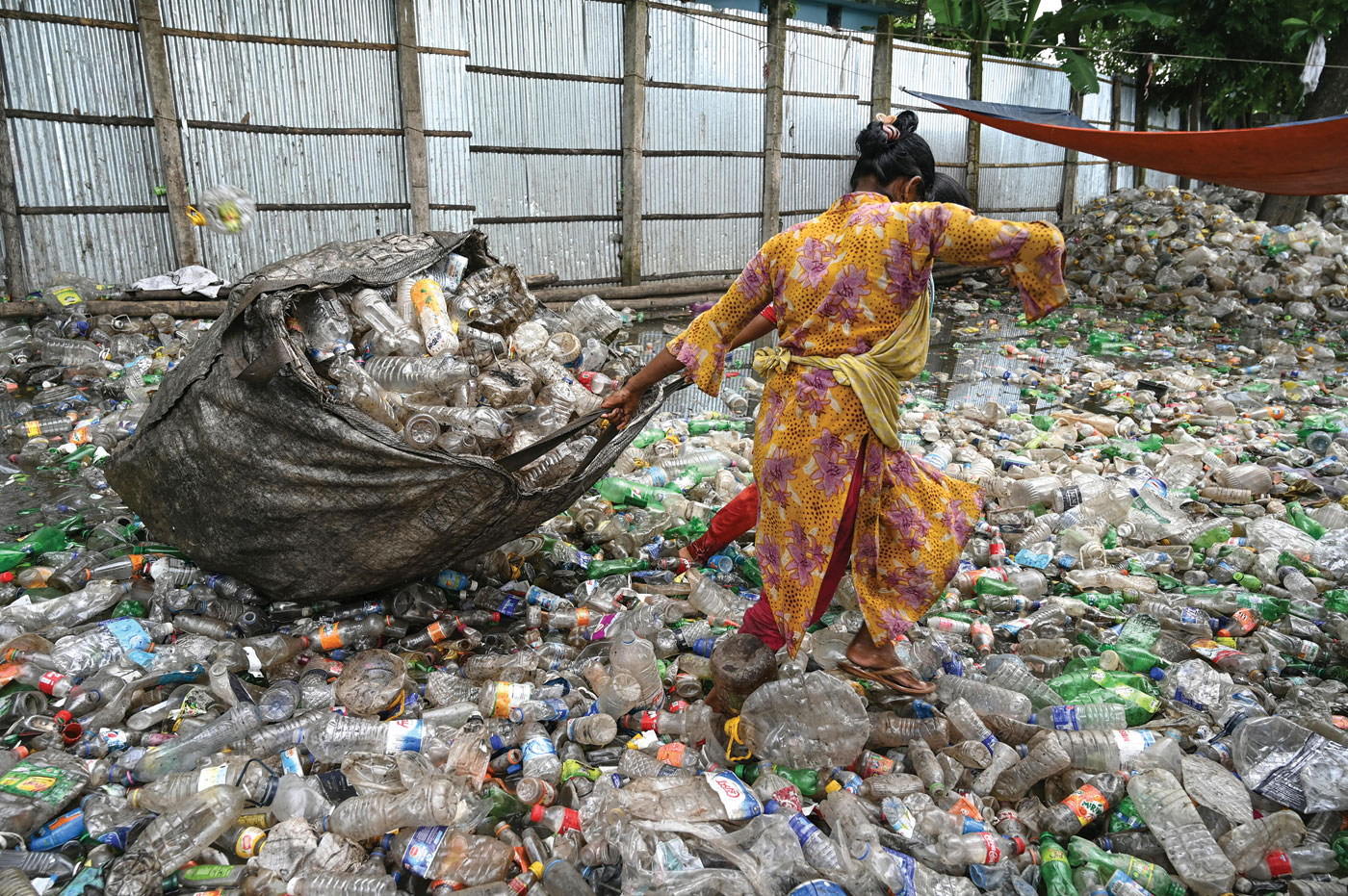
Annually, 14 million tonnes of plastic ends up in the oceans. Research indicates that terrestrial microplastic pollution is about four to 23 times higher than marine pollution depending on the environment. We need policies to dissuade use of batteries, plastic and unnecessary packaging. Photo: Public Domain/Mumtahina Tanni.
Sanctuary spoke to citizens across the country from various fields on what they wish will guide the course of the country’s environmental future. They chart out their hopes that the new India will fight the global environmental crisis and work toward tackling climate change, addressing agriculture woes and stemming biodiversity loss. They ask for a paradigm shift with leaders at the State and Central level aligned with a mobilised civil society to work actively to safeguard our economic and environmental future.
Climate Change Must Be Addressed Head On
By Haripriya Gundimeda
India needs policies to arrest the growing menace of climate change irrespective of what the rest of the world does. India has a net zero vision, but what should the country do to achieve this? What kind of practices do we need to follow and what strategies do we need to adapt? For this, we need to identify the key stakeholders or contributors to climate change.
The first and foremost contributor obviously is fossil fuel usage (or the energy requirement of the nation). There should be a decreased reliance on coal. Though it can be argued that India has abundant resources of coal and we can be self-sufficient by exploiting these resources, on the contrary, the cost imposed by coal (negative externalities to well-being) are huge. Our emphasis should be on renewable sources of energy. Reduced dependence on coal would also improve our forest cover as well (which is an absolute necessity for tackling climate change).
The demand for energy comes from transport, industry, agriculture, and households. All the four sectors require improved resource efficiency before finding new solutions.
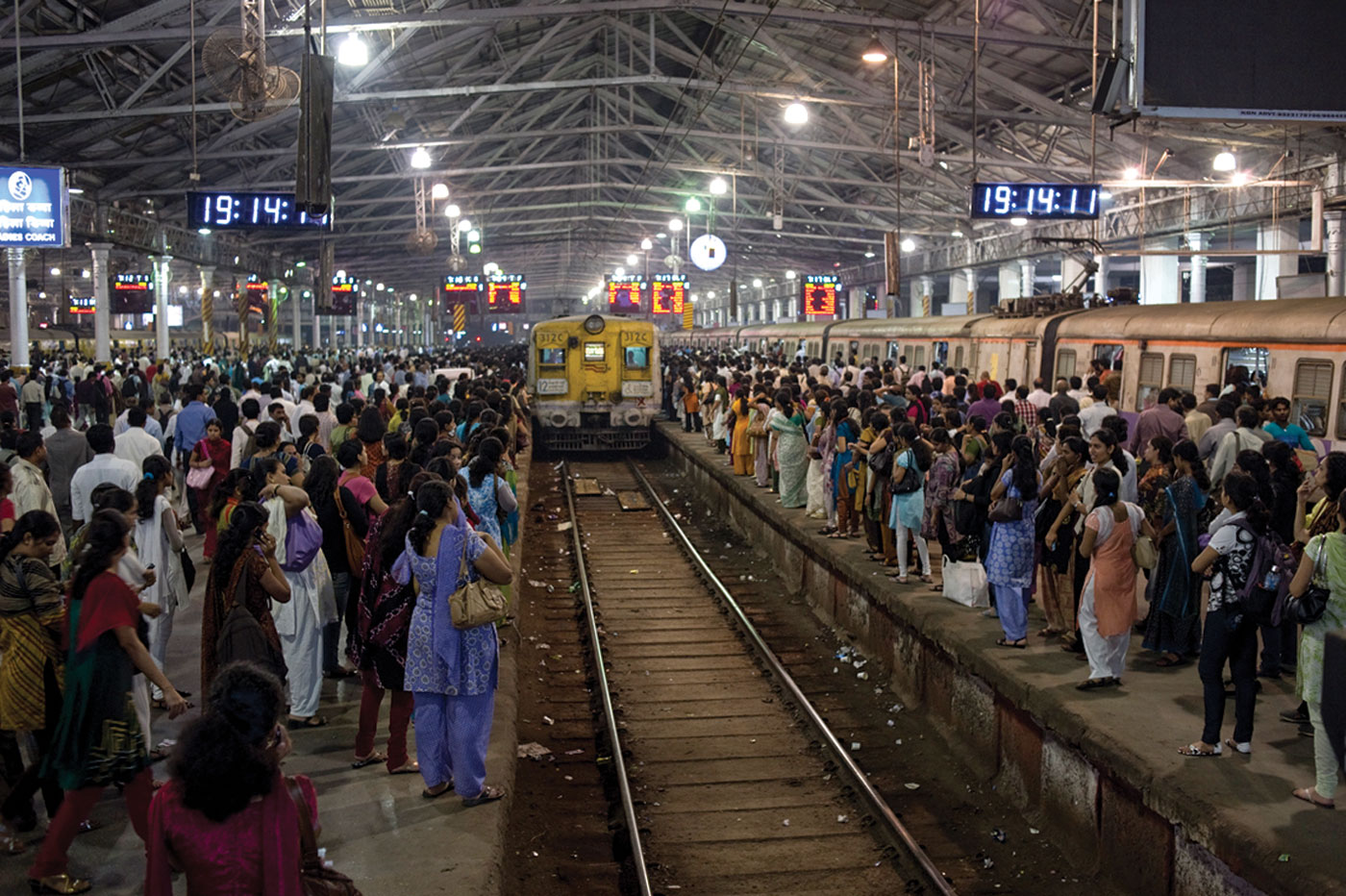
Apart from Mumbai and Delhi, hardly any top tier cities in India can boast of a robust public transport system. We need to make some huge shifts in priorities pertaining to increase and improvement of public transportation systems across the country. Photo: Public Domain/MM.
Traffic and congestion in Indian cities are a major source of resource inefficiency. To improve resource efficiency, we need to improve the quality of roads (not just build new roads). It requires improved traffic management, better management of heterogeneous traffic, ensuring good quality roads (with no pot holes or bumpers). Once we fix this problem, other solutions such as green energy, clean fuels etc. can be explored.
The industry needs to adopt a ‘cradle to grave’ approach. While a lot of work is being done on using lesser resources for manufacturing products, the longevity of the product is not considered. The life of the product has been shortened, and the implications of this for the environment and resource abundance has not been considered. Once we have a vision of improving the longevity of products, the next step is resource recovery. We do not have a proper policy on reuse of resources after the life of the product ends. While consumerism is a growing concern, there is no policy for producer responsibility management systems.
Agriculture has a lot of resource inefficiency. Though technologies are available to improve water delivery mechanisms such as drip irrigation and solar irrigation systems, we need policies to improve the quality of soils so that we rely less on fertilisers and pesticides, which also harm the ecology and environment, health, and well-being in addition to climate change.
Finally, and most importantly, we need improved resource efficiency from the household sector. We need to create awareness on the need for adapting practices for improved resource efficiency. How effectively are we disposing of solid waste? Do we have resource recovery from household products? We need policies to dissuade use of batteries, plastic and unnecessary packaging.”
Professor Haripriya Gundimeda is an Institute Chair Professor in the Department of Economics, IIT Bombay.
Negative Impacts Will Come At Us From Many Fronts, We Need A Huge Shift In Priorities
By Paul Abraham
The first issue, one of paramount importance, is the impact of climate change on agriculture and the disruptions in terms of livelihood loss and supply chain disturbances. Many corporates thrive on being part of the agriculture supply chain e.g. food processing, dairy, transport, storage and warehousing, and logistics. With increasing uncertainty will come higher insurance premiums and a general reluctance to provide cover. There is already talk of reluctance to provide crop insurance. Similar challenges will be faced by industries such as hydel and coal mining, where reluctance to provide cover will increase cost of doing business. Even where the local government is keen to support, international reinsurers will succumb to pressures from their constituents. For example, Bhutan’s desire to be a Carbon Positive country meant they curtailed their tourist inflows to minimise environmental damage. They charge tourists over Rs. 1,000 for each day as contribution to a sustainability development fund. While this is a great initiative, it has impacted tourism and general support industries negatively.
The large-scale international linkages will expose us like we see with cross border water agreements. With sources drying up, the possibility of reneging on agreements will create broad insecurities. Absence of natural resources such as water will cause large-scale hardship and migrations. In fact, in addition to issues of geopolitics, even domestic challenges will arise. Like we saw recently with Haryana curtailing water stock to Delhi. This could create risks in locating business in certain geographies and also lower ease of doing business indices. This would have serious repercussions on economic activity in certain states.
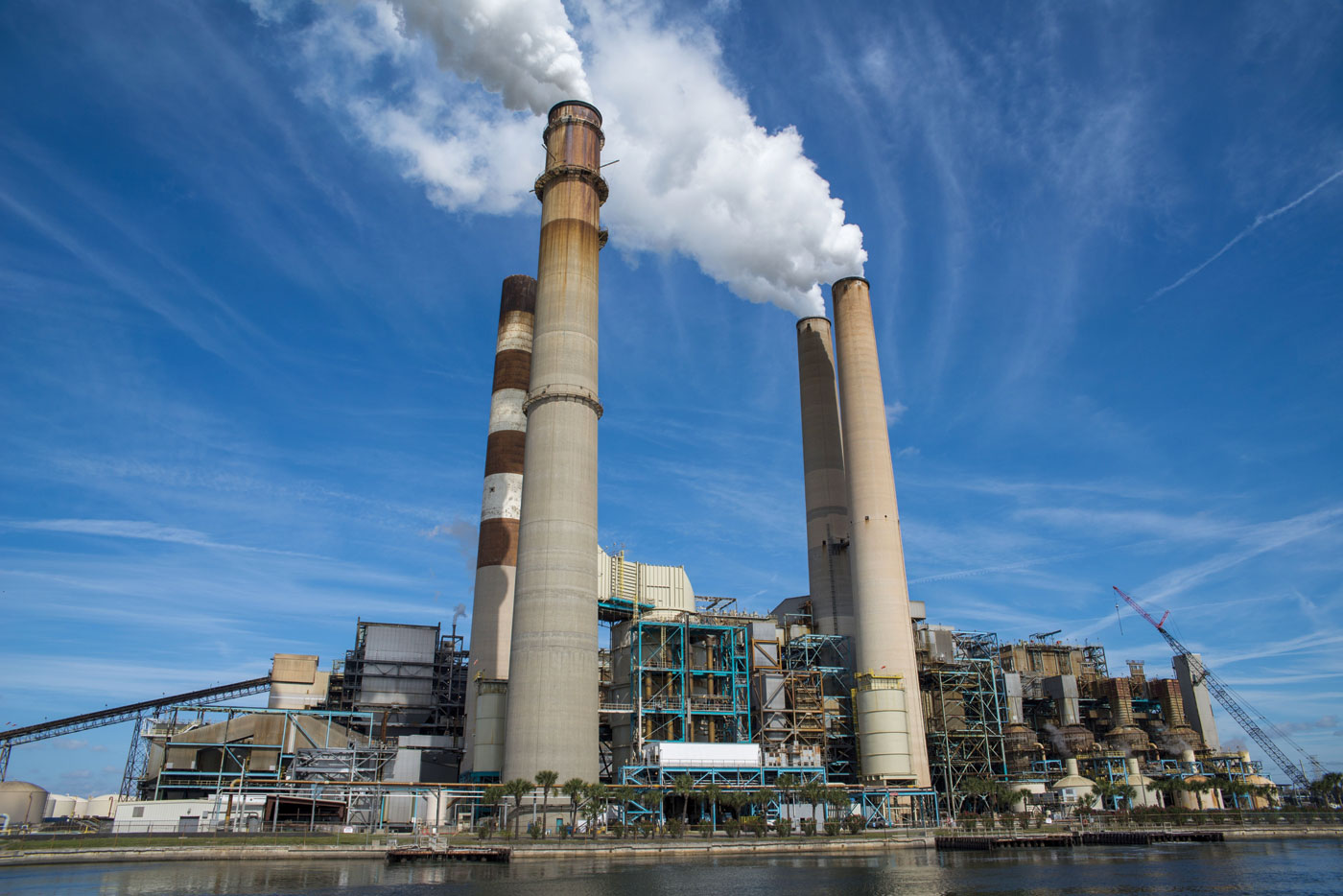
Fossil fuels are one of the largest contributors of air, and water pollution leading to global warming. Minimising fossil fuel dependency and closing unsustainable industries should be some of our urgent targets. Photo: Public Domain/Rawpixel.
Quality of life is another area where people will suffer. With pollution, floods and unpredictable temperature patterns, people will see impact to health, and the resultant consequences could lead to loss of productive time and corporates facing increasing health cover burden. Children would be particularly vulnerable with health and consequent attendance challenges.
High employment industries such as tourism will be impacted severely because of the concerns around climate events such as floods, landslides, shifts in temperature zones and more.
India needs to make some huge shifts in priorities. I would like us to increase and improve public transportation systems. There is a need for more research on storage technologies and more EV- and hydrogen-based transportation without creating new zones of unsustainable practices such as battery technology.
It is vital that we increase tree cover and green spaces to ensure resources such as water are improved and guaranteed, decrease urban pollution levels, and increase green spaces.”
We also need
1. Clear targets for closing some unsustainable industries and minimising fossil fuel dependence
2.Pricing of scarce resources, especially water
3. Crop patterns that align better with resource availability
4. A more sensitive approach to development initiatives that protect the local stakeholder
5. To increase mind share through massive awareness both in schools and corporate bodies.
Paul Abraham is the President of the Hinduja Foundation, which works in key areas of water stewardship, health and education. Advisor at IndusInd Bank, his banking career has spanned over 38 years. He also founded the Sarmaya Museum to foster a love for art and history.
We Need A Multi-Pronged Strategy From The Government, And We Need To Speak Up To Protect The Environment
By Dia Mirza
Even though climate action did not feature prominently in the discourse around elections, hopefully in the next five years, it will be scaled up with a decisive focus on Sustainable Development Goals (SDGs). The recent onslaught of an unprecedented heatwave and torrential rains has once again revealed to us our climate change vulnerability. The former Executive Director of United Nations’ Environment Programme (UNEP) Erik Solheim has also underscored India’s vulnerability to climate change on account of heavy population, pollution, loss of nature as well as wildlife, and the destruction of forests.
I hope the new government will formulate a multi-pronged strategy to address issues such as rising air pollution, the proliferation of unmanaged plastic waste, seasonal forest fires, the loss of green cover and diminishing wildlife habitats. The transition to clean energy, a stronger commitment to emission mitigation targets, initiation of afforestation projects, protection of endangered species, and supporting sustainable farming practices will help us to further impact the climate narrative in the Global South. The way forward however is fraught with many challenges.
A 2023 report informed that India is responsible for eight per cent of the diversity of wildlife with only 2.4 per cent of the world’s land area. It added that we have the world’s largest tiger range, the largest population of Asiatic elephants, and the highest density of one-horned rhinoceroses. It is up to us to ensure that what remains of our biodiversity is protected because our nation’s ecological sustainability and stability depend on it.
It gives me immense joy to see countless Indian women leading climate action, especially at a time when climate change and environmental degradation is disproportionately impacting them. Gender inclusivity was also one of the issues discussed last year when India hosted the G-20 summit and affirmed its commitment to SDGs, clean energy, climate resilient infrastructure, and more. I hope our policymakers will continue to synergise with stakeholders at all levels and with women to ensure that climate policies are equitable and gender inclusive.
On a sobering note, we are the world’s most populous country and our landmass amounting to just 2.4 per cent of the Earth has to provide sustenance to us all. However, in our demographic strength, lies our potential. If all of us made the SDGs central to the way we consume resources and if we stepped up to protect lung spaces, spoke up against pollution and embraced climate citizenship, we would also impact food, water, soil and climate security and help shape the policies that can make India greener, healthier, and more climate resilient.
Dia Mirza is an actor, producer, the UN Environment Goodwill Ambassador, and the United Nations Secretary General’s Advocate for Sustainable Development Goals.
Planetary Crisis Needs Urgent Attention And Action
By Praveen Gupta
After Hurricane Sandy hit the northeastern United States in 2012, TNC scientists in partnership with Lloyd’s of London found that coastal wetlands prevented more than $625 million in potential property damages by absorbing wave energy and reducing storm surge. Like Nature, insurance can be a healer and a destroyer. By investing in and insuring anything causing climate change, biodiversity loss and pollution – insurers aid and abet climate breakdown. This is the very reason why insurance is becoming unaffordable and asset classes in some geographies uninsurable.
Swiss Re has noted about the Protection Gap in 2023 that, “Only 38 per cent, or USD 108 billion, of global economic losses of USD 280 billion were insured. With climate change causing hazard intensification, asset accumulation and ever more people living in high-risk areas, impacts from natural catastrophes will only continue to grow”.
Proceedings of the Royal Society estimate the economic value of coastal and oceanic environments based on fisheries production, shipping traffic and carbon absorption at USD 2.5 trillion each year. The overall value of the ocean is estimated as an asset 10 times this figure. Oceans are climate regulators. Tinkering with them will trigger irreversible damages. Insured industrial polluting discharges, ocean going vessels and growing sub-sea mining will not only hasten the demise of our seas but humanity, as well.
Approximately $500 billion in agricultural subsidies worldwide perpetuate unsustainable food and land use systems, which lead to environmental degradation, poor nutrition and income inequality, warns Nature.org. If we do nothing about the way we produce and consume our food, it will amount to damage estimated to cost $16 trillion each year by 2050. However, by redirecting harmful subsidies toward sustainable practices, including regenerative agriculture, governments can accelerate international climate and biodiversity progress.
We are in a Planetary crisis. National boundaries are history. However, let’s take a look at India.
The recent spell of protracted heatwaves has demonstrated how India’s bottom-of-the-pyramid, in particular, remains helpless. Far, far away from the realm of insurance. Ironically, this base is growing.
Health and means of production remain in a precarious state for gig workers, small and marginal farmers, fishing community, women – particularly in unorganised sectors – and the rising army of senior citizens. Battling heat, humidity, water crunch and poor air quality, droughts, floods, sea level rise, ocean acidification, degenerating soil, malnutrition, disease – increasingly zoonotic in nature – pit our masses against the vagaries of climate, jointly and severally. An unfolding and magnifying polycrisis.
Mind you, every hour in India, 7,000 people slip into poverty on account of catastrophic health expenses. Imagine what the manifestations of climate breakdown possibly hold in store. In the absence of a dependable workforce, water shortages, erratic power supply, polluting power sector, unreliable supply chains – don’t be rudely surprised with a double whammy – a steep trajectory of insurance pricing followed by a rising uninsurable component.
To grow penetration of insurance under these circumstances will remain a rhetoric. Bharat and India are like the global South and North respectively. The systemic will, however, not spare either.”
Praveen Gupta is a former insurance CEO and Chartered Insurer who researches, writes and speaks on diverse subjects including environment and sustainability. Praveen is also a member of the Sanctuary Nature Foundation’s advisory board.
Youth At The Forefront Of The Resistance Movement
By Yuvan Aves
I deeply feel a non-majoritarian government, and the presence of a strong Opposition gives more hope for nature and nature-based communities, than the past decade.
Though one must remember that the word ‘climate’ hardly occurs in either manifesto – ruling or Opposition. We must also remember that in the past 20 years only 0.3 per cent of Parliamentary questions have been ecology related, as pointed out by Harini Nagendra, Director of the Research Centre at the Azim Premji University (APU), Bengaluru and Seema Mundoli, faculty at APU. It remains that environmental issues are disturbingly far from influencing Indian voting patterns and election turnouts, despite the country having hosted some of the largest eco-campaigns – from the Chipko movement to the Silent Valley to Mollem to EIA 2020. I think caste and class inequalities along with poor youth representation in political spaces creates this paradox. Meanwhile, the green party in the United Kingdom has won all four seats it contested, and in countries such as Brazil, Germany and New Zealand, environmental issues majorly sway political turnouts.
Indian politics needs a drastic shift, which will require too much political imagination and courage than one can realistically expect of it. At the outset, the binary between ecology and politics needs to vanish. All issues are issues of land, water, and life. Young people have been at the forefront of resistance movements in the past decade, which has perhaps been the most disastrous period for Indian nature. We need to acknowledge that resistance movements are nature’s greatest protection. With an Opposition representing the younger generation and demonstrating more receptivity, movements could go on without fear of incarceration. Nature needs to become deeply political. A dam project, deforestation for mining or a megaport proposal need to seal the fate of political candidates in support of these, making sure they do not return to power, and therefore making them very cautious about the environmental values they project, even if just for political reasons. For this, intergenerational diversity is crucial in governance.”
Yuvan Aves is a naturalist-writer, educator and Sanctuary Green Teacher of the Year, 2021.
Prioritise The Welfare Of Our Van Rakshaks
By Pranav Capila
For about 10 days in September 2010, I lived with Devender Singh, a forest guard, and Raghubir Singh, a daily wager, in a forest chowki in the Rajaji National Park. I walked out on patrol with them daily, ate what they ate, slept where they slept. The experience opened my eyes, not only to the physical difficulties that frontline forest staff face as they safeguard our Protected Areas (PAs), but to their isolation and desperation, and the distressing lack of facilities, equipment and training provided to them.
Sadly, little has changed in the last 14 years. The major issues confronting frontline staff remain unaddressed: Chronic staff shortages and erratic recruitment policies. Inadequate field infrastructure and equipment. No fixed duty hours. The need for sustained capacity building, for merit-based postings and promotions, for ration and hardship allowances in remote, difficult PAs (not just tiger reserves). The need for housing colonies with medical and educational facilities for the families of staff, adjacent to the areas where they are posted. The need to destigmatise and provide access to mental health counselling. The need to address the specific roles and requirements of female frontline staff.
_C-1400_1722576941.jpg)
It is also essential that issues related to daily-wage or contract protection staff are taken up, for these ‘non-permanent’ employees – who in several areas do the heavy lifting in terms of on-ground monitoring and protection – lack job security and do not even have the assurance that they will receive their meagre wages every month! Photo: Pranav Capila.
The 2017 National Wildlife Action Plan (NWAP) acknowledges the important role of frontline forest staff, but treats staff welfare as a mere afterthought. Some State Wildlife Action Plans (Maharashtra’s, for instance) fare far better, but the issue demands a dedicated push from the Central ministry. In 2013, an agenda item proposing that all states draft “a well-defined policy for the appropriate management and welfare [of forest staff]” was placed before the Standing Committee of the National Board for Wildlife (SC-NBWL). But in May 2014, a new government was elected and a new NBWL was constituted. This government would do well to take up the agenda that fell through the cracks.”
Pranav Capila is an editor and writer, who tells stories about wildlife, wild spaces, and unsung heroes on the frontlines of conservation.
Political Will For Organic Farming, Agro-Ecology Lacking
By Kavitha Kuruganti
It is important to ensure that our agricultural paradigm creates win-win-win solutions for economic, environmental and social justice issues, coupled with sustainability and climate change resilience. Such solutions exist in an agro-ecological paradigm and not in the Fourth Industrial Revolution (IR4) paradigm (as some would describe it). However, our leaders are dabbling dangerously with elements of this IR4 agriculture paradigm, promoting drone technology as a miracle solution, getting into agreements with companies such as Bayer with a notorious history of peddling poisons, and working with the Bill and Melinda Gates Foundation, which provides highly techno-centric solutions that help corporations profiteer without anything for the farmers. Ironically, India is also talking about natural farming, through initiatives such as Bharatiya Prakritik Krishi Paddhati, without really understanding what this whole paradigm is about, and without even releasing financial resources for the same. This dichotomy will not work.
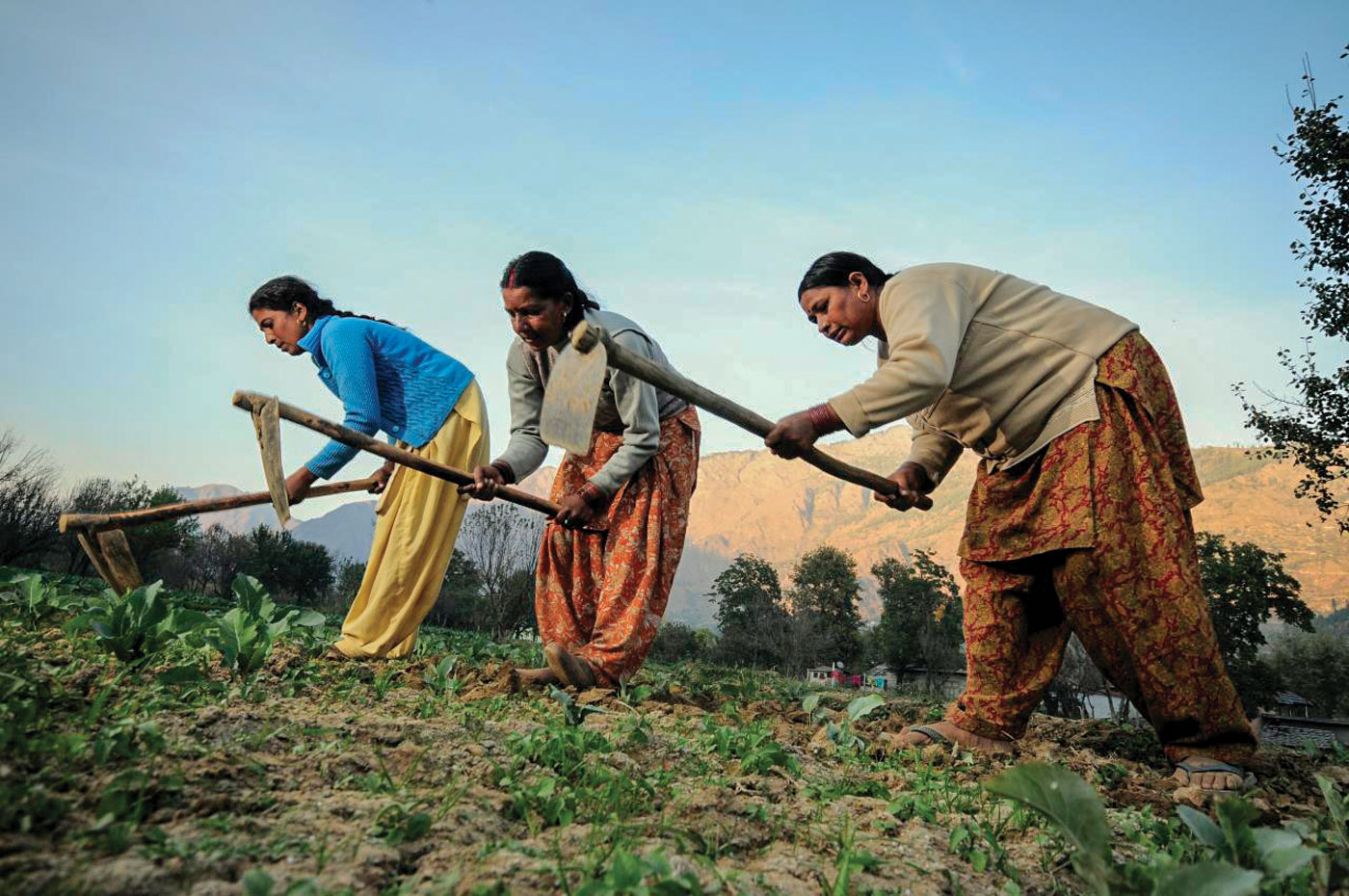 Women farmers at work in their vegetable plots near Kullu town, Himachal Pradesh. Previously, the area was a major producer of high-value apples, but rising temperatures in the last few decades have forced almost all apple producers there to abandon their crop. Organic and natural farmers, mainly women farmers, need to be at the forefront of our agricultural movement. Feeding the population with nutritious food is intimately connected with feeding the soil with good nutrition, and agro-ecological pathways are the best solution going forward. Photo: ©2011CIAT/NeilPalmer.
Women farmers at work in their vegetable plots near Kullu town, Himachal Pradesh. Previously, the area was a major producer of high-value apples, but rising temperatures in the last few decades have forced almost all apple producers there to abandon their crop. Organic and natural farmers, mainly women farmers, need to be at the forefront of our agricultural movement. Feeding the population with nutritious food is intimately connected with feeding the soil with good nutrition, and agro-ecological pathways are the best solution going forward. Photo: ©2011CIAT/NeilPalmer.
At another level, instead of focussing only on natural ecosystems being preserved through efficient use of existing agricultural land, can we begin by first discussing preserving natural ecosystems with community involvement? Why not talk about repealing the Forest Conservation Act Amendments for better protection of forests? How about ensuring that more diversion of agricultural land to non-agricultural uses does not happen?
For us, agro-ecology is the way forward, by which natural ecosystems can be preserved. However, that can happen if there is enough investment made on spreading agro-ecology to all farmers, through knowledge-driven processes and institutions. The mainstream agricultural research establishment is ill-equipped to do this. This requires practising organic and natural farmers, mainly women farmers, to be at the forefront. Feeding the population with nutritious food is intimately connected with feeding the soil with good nutrition, and once again, agro-ecological pathways are the best solution going forward. The Indian Council of Agricultural Research’s (ICAR’s) all India coordinated research/network project on organic farming has irrefutable evidence on overall benefits, including better yields from organic farming. The government now needs to show its political will in adopting this as the mainstream paradigm.”
Kavitha Kuruganti is the Co-Convenor of the Alliance for Sustainable and Holistic Agriculture (ASHA).
India Has The Tools And Economics But Needs To Invest In Restoration And Better Implementation
By Julian Matthews
India has a proven track record in nature restoration success – paraded today as a ‘turnaround specialist’ on a landscape scale – but it’s usually come at a point where a species or habitat has almost gone extinct or been denuded, be it a species such as the one-horned rhinoceros or Bengal tiger, or wildlife reserves such as Ranthambhore or Sariska.
Today India has all the tools in the nature recovery box, with expertise and experience – and now the economics to match, to be one of the world’s greatest conservation success stories. It has, after all, succeeded, despite all the enemies of planetary sustainability: relentless population growth, unplanned development, ongoing deforestation, extraction, river and air pollution, poverty and exploitation, that it is too often better known for.
With India increasingly becoming a key driver of global economic wealth, it is critical that the new government leads in words and action on nature recovery and climate mitigation, given that we now know both the solutions and the actions needed to restore planetary health, as well as having the economic wherewithal to do it and the economic data to prove its return value.

India has a proven track record in nature restoration success – paraded today as a ‘turnaround specialist’ on a landscape scale. However, this has usually come at a point where a species such as the one-horned rhinoceros or Bengal tiger or a habitat such as Ranthambhore or Sariska have been pushed to the brink. Photo: Siddannavar Praveen/Sanctuary Photolibrary.
This means ‘investing’ in nature recovery, investing in regenerative farming and soil health, investing in clean rivers and freshwater, investing in renewable energy and clean transport. It also means disinvesting as fast as possible in fossil fuels, polluting industrial products and processes and poorly planned growth and development.
With climate change disproportionately affecting India, I would like to see the restoration of nature, soil health and climate mitigation – being put on a ‘war-like footing’ – where government departments, society and industry work together to tackle these twin crises in a planned, coordinated and command structured way. It’s a challenge but without this type of sustained collective action, the competing realities of both central and state government departments, and commerce and society will simply not be able to tackle these existential problems head on – and we will continue to pass the planetary tipping points into uncharted and ever more dangerous (and costly) crises.”
Julian Matthews is founder of TOFTigers in India, a rewilding campaigner and a sustainable nature tourism operator.
The Government Must Act Immediately
By Dr. Anish Andheria
There are many actions that India will have to carry out on war footing in the field of nature and wildlife preservation if she wants to be resilient against the challenges presented by climate change and biodiversity loss. To start with, the people in power will have to recognise that nature is the conveyor belt for realising our political, social, and economic aspirations and stability. Rather than providing a broad-brush wish-list, I would like to be more specific about the actions that the current government will have to prioritise to give our natural ecosystems the respect they deserve.
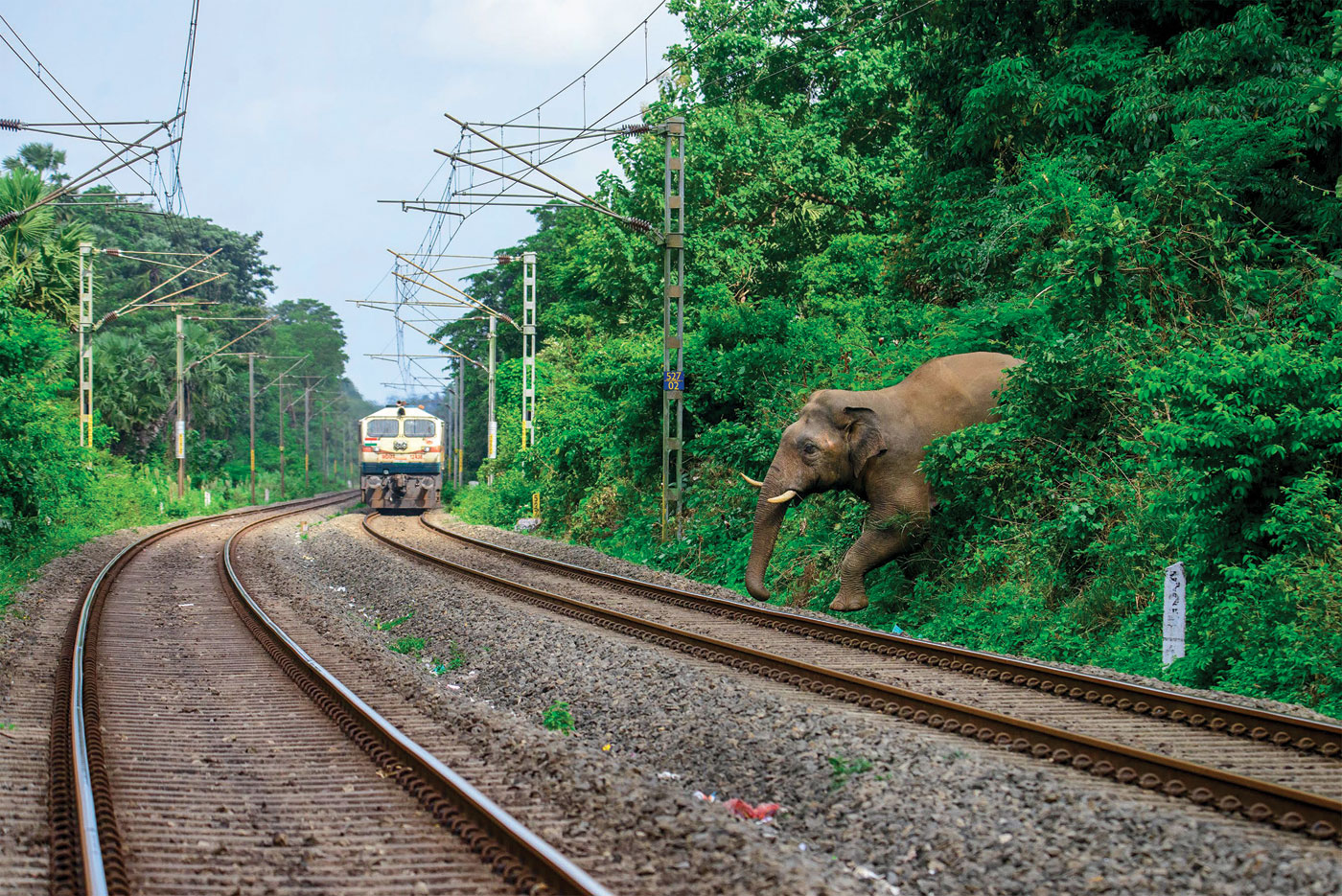
Linear infrastructure, such as roads, railways, canals, and powerlines, though vital for development, cannot be allowed to further fragment India’s wilderness. Their impact on biodiversity, wildlife migration, introduction of alien invasive species, and illegal wildlife trade is well-known from long-term studies carried out across several continents. Photo: Aneesh Sankarankutty/Sanctuary Photolibrary.
. Strengthen the Forest Department, in terms of finances as well as training. The ever-growing human-wildlife interactions are going to act as a flashpoint between people and Mother Nature, on which they so dearly depend. Unless the Forest Department finds innovative, non-monetary ways of mitigating these negative interactions, we will lose a lot of biodiversity because of retaliation.
. Linear infrastructure, such as roads, railways, canals, and powerlines, though vital for development, cannot be allowed to further fragment India’s wilderness. Their impact on biodiversity, wildlife migration, introduction of alien invasive species, and illegal wildlife trade is well-known from long-term studies carried out across several continents. A very high proportion of roads that India will have by 2040 are not even built at the moment. As a result, India has the opportunity to learn from the mistakes of the developed nations, and follow a much greener development trajectory than them. The government should ensure that linear infrastructure is not allowed to infringe upon natural infrastructure (read ecosystems), and necessary mitigation measures must be incorporated along all linear infrastructure passing through wildlife corridors.
. Expedite the notification of ‘Core and Critical Wildlife Habitat’ as per Sec. 2(g) of the Forest Rights Act (FRA), 2006. ‘Critical Movement Areas and Riparian Areas in Wildlife Corridors’ should be placed at par with ‘Critical Wildlife Habitats’ in Sec. 2(b) of FRA. Additionally, Sec. 4(2) must also include ‘Wildlife Corridors’.
. Make State rules by exercising powers under Section 64 of the Wild Life Protection Act (WLPA), 1972 to give legal status to corridors, and implement prescriptions listed in the Corridor Conservation Plans that would help protect corridors and their functional values. Amendments will also be required in all land-use-related Acts to ensure that only green infrastructure is built in the identified corridors, and that the existing infrastructure is appropriately retrofitted.
. The Government of India (GoI) should change the nomenclature of ‘Compensatory Afforestation’ to ‘Compensatory Reforestation’. Identify and map areas for compensatory reforestation, preferably adjoining the existing Reserved Forests/Protected Forests (RFs/PFs) and Protected Areas (PAs), and issue a government order to put a stop to planting of woodland species in grasslands, thorn scrub, rocky blanks, and other non-forest habitats.
. Free-ranging and stray dogs are massacring all manner of wildlife from the trans-Himalaya to deserts, grasslands and forests. The ABC (Animal Birth Control) programme of the government is not effective in putting an end to this menace. There is an urgent need to develop an unambiguous policy and develop institutional mechanisms to manage the populations of stray dogs and cats in and around PAs and corridors to minimise the killing of wildlife and to control the spread of diseases such as canine distemper and rabies in wildlife. Just as several State governments have granted permission to ethically eliminate wild animals such as wild pigs and nilgai when they enter agricultural land to stop crop loss, permissions to eliminate free-ranging dogs inside PAs should be considered before it is too late.
. The Wasteland Atlas needs to be completely revamped. It is an archaic document and has extensively damaged non-forested ecosystems such as grasslands, deserts, and marshlands. Solar- and wind-power installations are being planned in some of the most vulnerable ecosystems as they are wrongly categorised as ‘wastelands’ since the time of Colonial rule.
. Fair and just voluntary relocation of people who are willing to move out of PAs should be promoted to rejuvenate the rapidly degrading ecosystems, and provisions should be made for access to quality education, health and livelihood opportunities to the marginalised. The poorest of poor are more directly dependent on natural resources than other economic strata. Quality ecosystems are a pre-requisite for their survival in this rapidly changing world. CAMPA (Compensatory Afforestation Fund Management and Planning Authority) money should become an important funding source for the above.
. Develop a national Wildlife Disease Surveillance and Management protocol, which mandates the screening of all seized wildlife (living or dead) for zoonotic and other pathogens. Develop a disease risk analysis protocol involving wildlife diseases such as foot-and-mouth disease (FMD), tuberculosis, rabies, canine distemper, feline panleukopenia (FPL), haemorrhagic septicaemia and blackquarter (HS BQ), avian influenza, haemoprotozoan diseases, and African swine fever, at the wildlife-livestock interface. Establish a mechanism to collect biological samples for disease surveillance from road kills.”
Dr. Anish Andheria, scientist, field biologist, conservationist and photographer is the President of the Wildlife Conservation Trust.




_C-1400_1722576941.jpg)


